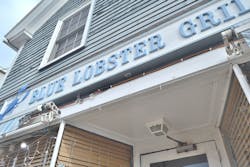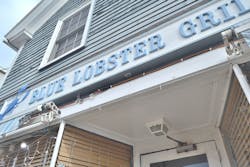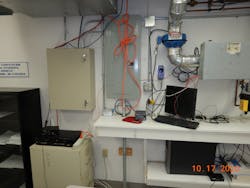What's Wrong Here? Hint: Is That an Extension Cord I See Below the Sign?
How well do you know the Code? Think you can spot violations the original installer either ignored or couldn’t identify? Here's your chance to moonlight as an electrical inspector and second-guess someone else's work from the safety of your living room or office. Can you identify the specific Code violation(s) in this photo? Note: Submitted comments must include specific references from the 2020 NEC.
Hint: Is that an extension cord I see below the sign?
Tell Them What They've Won…
Using the 2020 NEC, correctly identify the Code violation(s) in this month's photo — in 200 words or less — and you could win an Arlington Industries 18-in. Slider Bar and plastic box for mounting between studs with non-standard spacing. E-mail your response, including your name and mailing address, to [email protected], and Russ will select three winners (excluding manufacturers and prior winners) at random from the correct submissions. Note that submissions without an address will not be eligible to win.
October Winners
Our winners this month are: Dean Miller, an EC&M reader in Tipp City, Ohio; Hanna Camp, a registered professional engineer with Provost & Pritchard Consulting Group in Bakersfield, Calif.; and Craig Thoroughgood, a master electrician, State of New Hampshire, and air monitoring systems supervisor with Air Resources Division in Concord, N.H. They were all able to correctly cite the working space violation in front of this panelboard enclosure.
The shelving built in front of the panelboard encroaches into the working space required by Sec. 110.26(A). This space must provide working clearance for a minimum depth of 3 ft as specified in Table 110.26(A)(1) — and this space extends from the floor to a height of at least 61/2 ft as required by Sec. 110.26(A)(3). Section 110.26(B) prohibits the required working space from being used for storage. With all the obstructions in front of this panelboard impeding access to the overcurrent devices, we could also cite Sec. 240.24(A), which requires circuit breakers to be readily accessible.
About the Author

Russ LeBlanc
Owner
Russ started in the electrical trade as an apprentice in 1985. He worked his way up to become a Journeyman Electrician and then eventually became a Master Electrician and Licensed Construction Supervisor. In 1999 Russ become an Electrical Instructor for The Peterson School of Engineering in Massachusetts where he developed his passion for teaching, and quickly became Department Head of Electrical Instruction. Russ has taught thousands of apprentices, electricians, engineers, inspectors, and other electrical professionals during his career as an instructor. He continues to provide electrical professionals with Electrical Code seminars, Arc-Flash Awareness training seminars and educational material through his LeBlanc Consulting Services in North Reading, MA whose specialty is educating electricians. He has been an active member of the NFPA Electrical Section and has authored hundreds of National Electrical Code proposals and comments which have become Code rules to improve the safety for the electrical industry. Russ is also an IAEI certified Electrical Inspector.
Please visit www.russleblanc.net for more information.


